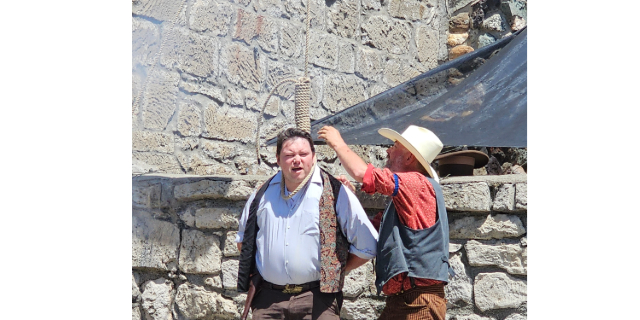Out of the Past: Oct. 9, 2019
Published 9:45 am Tuesday, October 8, 2019

- Above, Shane Brollier, who teaches agriculture and FFA at Monument School, explains a lesson to his students.
75 years ago
Prairie City soldier helps in delivering 350 Nazi prisoners
United Kingdom Base Communication Zone, European Theater of Operations, APO 413, U.S. Army, (Delayed) – Tired and grimy, but glad to be back after a safe return trip, members of a United States Army military police escort guard company who hit the Normandy beaches at the crack of D-Day noon passed through this port after delivering 350 Nazi prisoners to an enclosure on the shore.
Coming in under shell and rifle fire on June 6, a Higgins landing boat carrying the MP’s was making good progress breasting the rough waters to the French coast until an 88 mm shell tore through the landing ramp and wrecked the craft.
By some sheer miracle, none of the men were hurt. With sniper and machine gun bullets whistling about their ears, with mortars and land mines crashing about them, the dauntless MP’s waded ashore in chin-deep water. German 88’s pounding away at the beach from the hills churned up the water and sand in huge geysers.
“Once on the beach,” said one of the MP’s, “we infiltrated to a plateau about five hundred yards away. There we dug in for the night, our clothes soaking wet. We had quite a time dodging the Uuftwaffe’s bombs until morning.”
“I slept in a foxhole half fully of mud and water,” said another. “Snipers bullets whined over my head all night long.”
By the next morning, they reported, the Navy’s concentrated and accurate bombardment of enemy coastel defenses had put out of action most of the troublesome 88’s.
Making their way through a curtain of fire laid down by snipers, the MP’s trekked a half mile inland to a point where a prisoner of war enclosure had been constructed by American engineers. Here they posted their security and settled down to making themselves at home in France.
During the next few days, as the situation on the beach was mastered by the Army and troops smashed against the Nazis, prisoners of war began to pour into the enclosure. The prisoners said they had been told by their officers that Americans never captured an enemy. Many of them were surprised to find that, far from slaughtering them, the Americans gave their prisoners fair treatment.
On June 10 the MP’s marched 350 prisoners, including seven officers and 30 non-commissioned officers, to an LST at the beach and sailed under cover of darkness to the English shore.
The MP’s agreed that all of them were looking forward to shuttling another bunch of Hitler’s “supermen” to prisoner-of-war enclosures on this side. Among the MP’s of this escort guart unit were: Pvt. Joseph J. Biesyczad, Chicago, Illinois; Cpl. Leon Oginsky, Worcester, Massachusetts; Pvt. Withrow T. Dreyer, St. Louis, Minnesota; PFC. John W. Gwyn, Prairie City, Oregon; PFC. Charles D. Miller, Lewiston, Pennsylvania; and Pvt. Joseph G. Hare, of Philadelphia, Pennsylvania.
25 years ago
It’s just another ‘typical day’ for the OSP
The dark rain clouds forma backdrop adding to the cool morning hours and ever-changing trees of Grant County. It’s a typical fall day in John Day and Oregon State Police senior trooper Mike Durr prepares for another shift of patrolling the roads and assisting the citizens of the area.
The daily work of a law officer is filled both with routine and excitement. For Durr the regular rounds for this day begin with a drive toward Prairie City to deter potential speeders.
“This shows the people that we’re still here,” explained Durr, who tries to cruise the roads around the county to let the drivers know that the OSP is around. “This (drive) will slow most people down for at least a couple of days.”
Lately Durr hasn’t been able to get out as often as he would like to check on the highway drivers, adding that over a period of time a motorists’ speed gradually increased when not shocked by the sight of a patrol car.
Durr is the only OSP officer who patrols the county. The John Day OSP department usually staffs a maximum of two fish and wildlife officers, three road troopers and one sergeant. They currently have two fish and wildlife officers, Sgt. Dick Tenderella and Durr.
Both open trooper positions have been listed as critical throughout the state. This signifies that the OSP would pay for moving expenses to come here for whomever wanted to transfer to this post.
“I don’t understand why we haven’t had any takers,” said Durr. “Especially for the troopers living in Portland. Some people like it better there I guess. It’s definitely a faster pace.”
On this morning patrol Durr catches a young man who is a little late for work.
“Did you see the nose of his car dip,” Durr exclaimed, indicating the driver used his brakes suddenly when he saw Durr coming. The patrol car swings around and is shifted into overdrive.
The driver knows he’s been caught by Durr’s window-mounted radar gun and pulls over to the side of the road before Durr even stops to turn around.
“I don’t think I’ve ever had anyone admit that they’ve ever gone faster than what I’ve clocked them at,” explained Durr after he returned to the patrol car. The driver was clocked going 68 miles per hour and he admitted to doing 72 to 75 miles per hour when Durr walked up to his car.
The next step is to retest the radar. A routine that is down before every shift and after someone has been pulled over. A pair of tuning forks are pulled out of a Velcro pouch on the dash and hit together. Durr places the forks in front of his radar gun and waits for a signal to come out of the computer that displays the speed on his dash. The gun works and the patrol continues.
Some of the things that the OSP looks for on its regular patrols is to look for all moving violations, bad passes, accidents, running stop signs, speeding, license and equipment violations and anything else that might be out of the ordinary. On this particular day Durr also had to stop and throw two dead animals off to the side of the road.
“We have to get them out of the road so people won’t swerve to try and miss them and hit someone head on,” said Durr.
While on patrol an officer has to avoid getting into a relaxed mode, which is really easy to get into, when pulling over a car explained Durr.
“You never know who you’re stopping,” said Durr. “You basically don’t know what that person may have done five minutes earlier. They could have killed someone or stolen a car. You really have to pay attention when you’re walking up to the car.”
This element of excitement keeps Durr focused on each stop when walking up on the driver. To a trooper, each stop is an investigation.
“You’ve got to be curious all of the time,” added Durr. “It’s something you acquire over time. You have to think what you are doing all the time.”
After years of experience in the OSP, Durr says he can read people by their actions and behavior and knows when something is wrong with the situation.
“You get some strange stuff out here,” explained Durr adding that officers have to be careful what they say and people can easily twist their words around. “You’ve got to keep your sense of humor too. Nobody likes getting a citation. I try to make it as painless as possible, but it’s not always easily done.”
Getting the feel for the job took Durr a while to get used to, but he added its just like any other job in that it takes a while to fit into your own niche.
It’s been 16 years since Durr joined the state police. His training began at the Redmond Air Center, just a few miles north of his hometown of Bend.
“This is something I’ve always wanted to do,” explained Durr. “My dad was with the OSP and there’s nothing else I really thought of doing when I was a kid besides this.”
Astoria was Durr’s first assignment. He spent four years in the coastal town until he transferred from his trooper position to become a fish and wildlife officer. He then spent two years in Portland before an opening came up in John Day.
Durr spent his first eight years in John Day as a fish and wildlife officer and then transferred back to his original trooper position last year (1993).
“I lived all year long for the hunting season,” he said adding that he transferred last year so he could start taking his son hunting.
Times have changed since Durr was a trooper. When he first started, OSP training lasted only nine weeks. Now it takes 16 weeks. The duties of an officer have also expanded along with the training.
“When I first came onto the force it was almost totally traffic oriented,” he explained. “Since then there has been a shift to more law oriented things. More than I ever dreamed of.”
Training is always updated and ongoing for Durr, who added he doesn’t mind the new service-oriented policing explaining that this is what the people of the community want the OSP to do for them.
“People are becoming more aware that they have to become more involved,” said Durr. “Especially in a small community, the people are more supportive of us.”
The definition of the OSP is to enforce the laws of the state of Oregon and motor vehicles is just a small part of that Durr explained. Other OSP duties include emergency locates, assisting disabled boats, writing accurate reports, preserving whatever evidence there is on a particular case and having to testify in court.
The OSP also works cooperatively with the John Day and Prairie City police and the Grant County Sheriff’s Department.
“That’s one of the reasons the OSP was formed,” said Durr. “Part of our mission is to provide assistance to local agencies. We provide a lab (in Ontario) and we’re always backing each other up on calls.”
On a local level each call varies and is approached with a different mindset. Durr always prepares himself with the worst-case scenario when responding to a call.
“That way when I arrive anything less is easier to deal with,” he explained.
For traffic accidents he imagines a number of people being injured and all of them needing first aid with no one there to help him. For a theft or burglary he prepares the routine questions of where the missing property was last seen, if there are any suspects and the motive of the suspect. Domestic disputes involve separating the two parties if physical combat s going on and trying to diffuse the situation added Durr.
The life of a law officer is a demanding one and Durr copes with each situation as they develop with caution, excitement and curiosity during his day and night patrols.
“I can’t imagine working anywhere else,” explained Durr. “I’m lucky enough to be able to make a living in a rural setting like this. This is my heaven.”
10 years ago
Faithful return to small school
The 2009-2010 school year has kicked off in Monument with all eight teachers back on board and ready for a busy year.
According to Superintendent/Principal Michael Reule, a couple of new classes – forensics and animal science – are already generating excitement this year. He added that they are continuing to offer calculus and chemistry too.
The popular robotics club is also back for another year.
And music instruction is available at the school two days a week, Reule said, along with after-school lessons for any child or adult in the Monument community, through a partnership with Ethos Music.
Reule reported that enrollment in all grades, kindergarten through grade 12, is 55 for 2009-2010, up from 52 last year.
“Three students may not sound like a lot, but that is a 5.6% increase,” Reule said.
There are 17 students in the high school, four in the senior class. There are no freshmen this year.
Three teachers cover the elementary classes, broken down into groups: Kindergarten and grade one; grades two and three; and grades four-sex. The other five teach grades seven through twelve.
Reule said that Monument School is marking 20 years of their sports co-op with Dayville School.
Started in 1990-1991, the pair of small schools combined forces for football, volleyball, and boys and girls basketball.
This is the second year that Long Creek has joined in for football.
Reule added that the school board adopted “improving writing” as the goal for 2009-2010.
“This coincides with writing as our ‘school improvement goal,’” Reule said.
“Even early in the year students are appreciating the quick feedback on their writing and are striving to improve their performance.”
Monument School also boasts a new concession stand in the gym, built largely from community support.
Students will be on the go and out of town early on with field trips: Oregon Museum of Science and Industry, Oct. 21 and 22 and Camp Hancock Field Station in Wheeler County, Oct. 26-28.
Reule said that excursions to Oregon Health and Science University and the Oregon Zoo are also planned and the Missoula Children’s Theatre will present “Snow White and the Seven Dwarfs” at the school in April.





